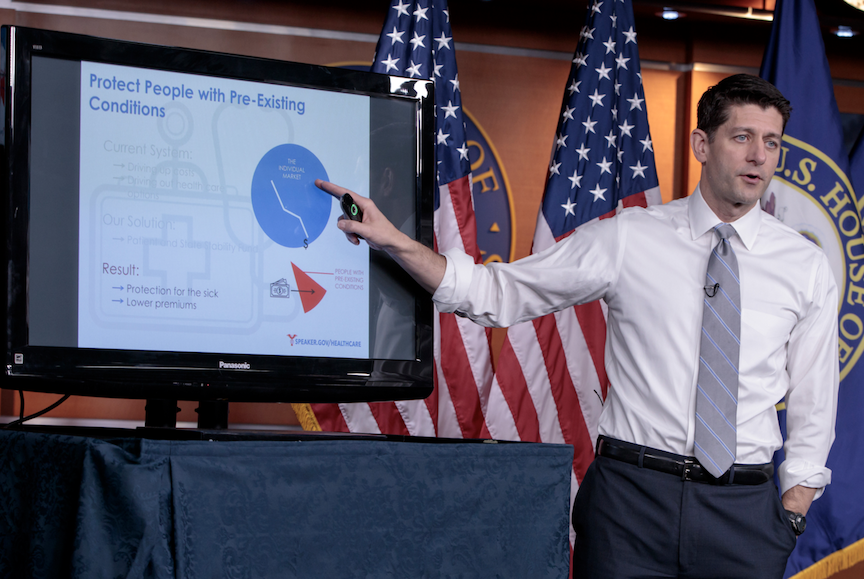
Who knew healthcare could be so complex? The GOP proposal for health care reform rests on health savings accounts and high deductible health plans. The basic premise is that price opacity, and deep pocketed third party payers drive up the cost of health care. Giving patients dollars in health savings accounts they control should make them price sensitive, and thus help reduce the cost of healthcare. A recent analysis by Drs. Chandra and others provides an interesting perspective on the matter.
The researchers took a large self insured firm that required all of its employees to switch from an insurance plan that provided free healthcare to a nonlinear, high deductible plan. The switch worked. Health care spending was significantly reduced, but the concern was the mechanism by which spending was reduced. One would like to believe spending reductions related to price shopping, so patients were getting the same services just for cheaper. Unfortunately, it appeared that consumers reduced all spending regardless of whether it was worthwhile or not. Deciding what is worthwhile in healthcare is a complicated business that I will leave for another day but I agree with the general contention of the paper – giving a patient control over health care dollars does not make for a smart price shopper.
I learned this the hard way when I chose a high deductible health care plan. I needed an outpatient CT scan as well as some basic labs. The local hospital was incredibly accommodating with its service as well as its bill 2 weeks later. Almost $2,000! No one told me the cost of any of this upfront, and I stupidly didn’t think to ask. I have learned much since – basic labs can be availed of for $30 in the right place, and imaging in hospital owned facilities is significantly more expensive. So when a patient (I’ll call him John) recently came to me with some concerning symptoms, and I ordered a CAT scan of the abdomen and pelvis, I was expecting the inevitable question: “Do I really need this doc? I have one of those high deductible health plans..”
To give you context – John is a 6 figure earning white collar individual who has an insurance plan on the individual market through the ACA. I explained my rationale, he found it reasonable, and I reassured him that I would attempt to find the cheapest place in the city to get a CT scan and get back to him. Thus began my little odyssey. Philadelphia is a town of hospitals – there are four academic medical centers in the city within a 10 mild radius of each other. So I first called up one of the academic medical center’s imaging center.
Me. I have a patient with a high deductible health care plan and was hoping you could tell me how much it would cost him to have a CAT scan of the abdomen and pelvis with and without contrast?
A. The cash price is $1100. That’s a 60% discount!
Me. A discount from what? Medicare?
A. Hesitating. Yes, Medicare..
Me. Are there outpatient facilities you own that the rate is cheaper?
A. Yes I think so. It has to do with proximity from the main campus. Location A and B have lower rates
Me. Is the price you quoted me the lowest rate? Could you tell me how much you charge for a CT Abd/Pelveis?
A. Yes. And no we can’t divulge that.
I next called two radiologists I know to ask if they knew any non-hospital owned imaging centers. There was one remaining center with a location just outside the city proper. A friendly receptionist picked up on the first ring.
Me. Hello, I have a patient with a high deductible plan… who needs a CAT scan of the abdomen and pelvis..
A. Our cash price is $440, but remember, this won’t apply to his deductible.
Me. Wonderful. He does have insurance, so do you have any idea what he would pay if he went through his insurance
A. I have no idea – we have different contracted rates for different insurances.
Me. Could you tell me what your fee schedule is? How much do you charge for a CT, just so I have an idea what he can expect to pay. I plan to send more patients to you, but would like to give them a sense of what they would pay going through insurance
A. I can’t tell you what our fee schedule is – but I can tell you that your patient won’t pay more than $2,000.
It should be clear to anyone paying attention that opacity forms the bedrock of American healthcare today. My attempts at transparency were only partially successful. What remained opaque was the imaging providers fee schedule, or their contracted rate with the insurance company. But I did find out enough.
The Medicare reimbursement can be looked up. Contrary to what I heard from the first imaging center – $1100 was not 60% of the Medicare rate. Medicare reimburses approximately $400 for this particular CAT scan. Commercial/private insurance reimburses approximately $1100. Medicaid reimburses ~$200. The cash up front rate at the academic medical center I called was $1100, and at a private non-hospital owned imaging center was $400.
| Medicare | Medicaid | Commercial Insurance | Uninsured (Nonprofit hospital) | Uninsured (For-profit private imaging center) | |
| CT Abd/Pelvis With and without contrast | $401 | $214 | $1,100 | $440 | $1,100 |
He elected to pay cash. He didn’t think he had other medical expenses that would put him over his deductible, and the contracted rate was probably 3 times what it was to pay cash. So just to repeat this to drive home the apparent idiocy here – the ‘negotiated’ cash rate for John is two to three times less than if he were to use his insurance plan.
So I called John with the news. I explained that the cheapest option was a private diagnostic imaging center just a mile outside of the city. I explained that if he used his high deductible health care plan insurance, I was not exactly sure what he would pay. He could call his insurance company to find out the contracted rate. My best guess was that the fee schedule for at least the private imaging facility was ~$2000, and that the contracted rate would be around half of that. Choosing to pay cash upfront would be cheapest, but that would not apply to his deductible.
I understand the rationale for the seemingly inflated rates at non-profit academic medical centers. On any given day they take care of complex patients with no insurance in their ERs or in the hospital, have to staff 24/7 teams of cardiologists to open occluded coronary arteries at 2 am, and have to staff hospitals to fulfill a dizzying number of meaningless regulations. Whether all of this should translate into a multiple of 3 for a CAT scan is also a topic for another day, but there are certain points that shouldn’t be in doubt when we think about about what to do with the 45 million patients who did not have insurance prior to the ACA.
Clearly, patients need a marketplace that allows them to price shop intelligently. It is hard to see how patients can do this without the help of a professional adviser. For the purposes of this post we can call this professional adviser a doctor, though I am certain some whipper snapper doing a pHd in something I can’t begin to understand will come up with a title that includes the phrase ‘care manager’. Of course, having a doctor on your side doesn’t much matter if prices are opaque. In the current system, having insurance automatically shrouds the cost of health care widgets in an impenetrable fog. Clearly more transparency would be helpful, but even price transparency and a doctor on your side isn’t enough!
Strangely, the problem is having insurance. Yes, you read that right. In this case, having insurance means being subject to some unknown negotiated rate that will then come out of your HSA. Perhaps transparency would force prices to be lower, though this is far from certain.
If this is about John and his ~45 million brethren that could potentially be on an individual market, it is more than a little unclear to this particular economic illiterate how insurance is helping here for the health care version of an oil change. You can perhaps understand why ‘MD twitter’ – as derogatorily referred to by health policy wonks – would be happy with any health care plan that gave patients the freedom to spend dollars from an HSA to pay cash for a CAT scan. You’ll also understand why the dim physicians trying to do the best thing for their patients may not quite understand the current handwringing about subsidies based on actuarial values.
The actuarial value refers to the total average costs for covered benefits a plan will cover. The ACA specified that beginning in 2014, insurance sold to individuals must be at one of four actuarial values: 60% (a bronze plan), 70% (a silver plan), 80% (a gold plan), 90% (a platinum plan). The ACA failed at cost containment because it gave patients and their physicians no good mechanism to exert any downward pressure on costs. If you got an ACA plan – and showed up at whatever random place (with hospital consolidation, you are much more likely to end up at a hospital owned facility) your doctor told you to get your CAT scan, you were likely to pay through the nose. If you had a subsidy you paid less, but the difference was picked up by the taxpayer. Hospitals, especially, loved this! It should come as no surprise, then, that actuarial values rose, and the costs in the form of higher premiums were passed on to the ever narrower band of unsubsidized patients who were buying plans on the individual market.
The effect of the new health care bill with its additional amendments is a mystery to me, and apparently the only folks with certainty about what is to come are economists and wonks. I am neither. Broadly speaking I have been supportive of patients having more flexibility and control of their health dollars. I say this not out of ideological zeal – I just want folks like John to be able to pay for his damn CAT scan out of the HSA account he funds! It is unfortunate that any move towards lowering subsidies, or increasing flexibility is met by a religious fervor from the left that would make Pentecostal Christians proud. It may be well intentioned, but it isn’t helping. Health care is complex and we need to to do a lot more than find a solution for John. Clearly the think-tanks have their work cut out for them – but would it really be a bad thing if policy econowonks started thinking like practicing doctors who see patients?
Anish Koka is a cardiologist, and wanna-be econowonk. He can be followed on twitter @anish_koka
PS. I also have to point out that after talking to two radiologists in the city, they could only think of one private, non hospital owned imaging center in the Philadelphia vicinity. It makes sense – why stay private, when you could make make much more money by selling to a hospital, and get paid a salary for doing less that was better than what you could do on your own?
